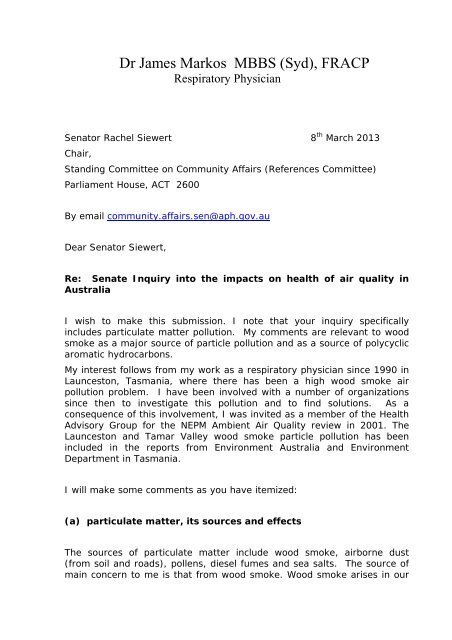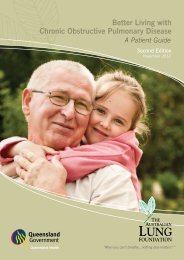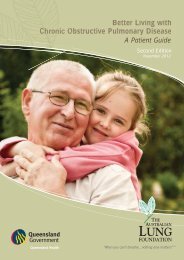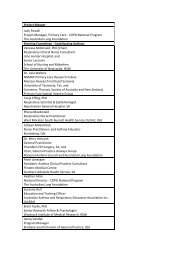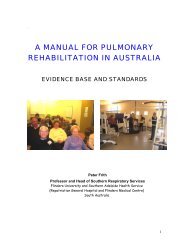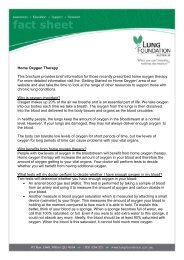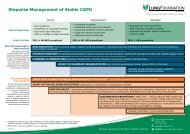view Dr Markos's submission - Lung Foundation
view Dr Markos's submission - Lung Foundation
view Dr Markos's submission - Lung Foundation
Create successful ePaper yourself
Turn your PDF publications into a flip-book with our unique Google optimized e-Paper software.
<strong>Dr</strong> James Markos MBBS (Syd), FRACPRespiratory PhysicianSenator Rachel Siewert 8 th March 2013Chair,Standing Committee on Community Affairs (References Committee)Parliament House, ACT 2600By email community.affairs.sen@aph.gov.auDear Senator Siewert,Re: Senate Inquiry into the impacts on health of air quality inAustraliaI wish to make this <strong>submission</strong>. I note that your inquiry specificallyincludes particulate matter pollution. My comments are relevant to woodsmoke as a major source of particle pollution and as a source of polycyclicaromatic hydrocarbons.My interest follows from my work as a respiratory physician since 1990 inLaunceston, Tasmania, where there has been a high wood smoke airpollution problem. I have been involved with a number of organizationssince then to investigate this pollution and to find solutions. As aconsequence of this involvement, I was invited as a member of the HealthAdvisory Group for the NEPM Ambient Air Quality re<strong>view</strong> in 2001. TheLaunceston and Tamar Valley wood smoke particle pollution has beenincluded in the reports from Environment Australia and EnvironmentDepartment in Tasmania.I will make some comments as you have itemized:(a) particulate matter, its sources and effectsThe sources of particulate matter include wood smoke, airborne dust(from soil and roads), pollens, diesel fumes and sea salts. The source ofmain concern to me is that from wood smoke. Wood smoke arises in our
communities from burning wood for home heating, industrial wood-firedboilers, back-yard burn-offs, rural vegetation burn-offs, planned forestryburn-offs and unplanned forest fires.Wood smoke contains fine particles which are breathed into the lungs.They irritate the bronchial tubes and affect those with pre-existing lungdisease, especially asthma, chronic bronchitis & emphysema.The adverse health effects of wood smoke have been shown consistentlyby numerous studies and are re<strong>view</strong>ed in the many Ambient Air QualityNEPM re<strong>view</strong>s. They include short term effects (hours, days and weeks)and long term effects (over many years). The adverse effects includedeaths, hospitalisations and ill-health without a need for hospitalisation.The particle levels in summer are usually 1 – 10 micrograms per cubicmetre of air per day (µ/m3). Some key studies have shown that for everyrise of 10 µ/m3 of daily particle concentrations, there is an increase of:• 1% of daily deaths from all causes,• 3% of daily deaths from lung causes,• 3% of daily admissions to hospital for lung disease, &• 3% of daily lung symptoms in the general population.There are also increasing concerns about the long term effects of inhalingwood smoke which are relevant to all persons exposed to environmentalwood smoke. A large study of 500,000 people from the USA investigatedthe causes of death over a 16 year period and concluded in 2002 thatlong-term exposure to wood smoke is an important environmental riskfactor for dying from heart or lung disease and from lung cancer. Thestudy corrected for the known risk factors for these diseases includingtobacco smoking. There have also been many reports from underdevelopednations about lung cancers developing in people cooking withwood stoves, often in poorly ventilated kitchens. The mechanism forcausing lung cancer may be by inhalation of polycyclic aromatichydrocarbons which are produced when wood is burned and which areinhaled with the particles.The harmful effects of wood smoke appear similar to those ofenvironmental tobacco smoke (ETS). We know there is no safe level ofexposure to this. Individuals can choose not to smoke and can usuallyavoid ETS. However, a resident of a valley filled with wood smoke cannoteasily avoid breathing in the polluted air.(b) those populations most at risk and the causes that put thosepopulations at riskThe populations at risk are all people who have frequent high exposure towood smoke as well as those with those with lung disease (especiallyasthma, chronic bronchitis & emphysema). The proportion of Australians
with a serious lung disorder is estimated at 1 in 5. This is a very highnumber of people at risk. The very young and the elderly are also at ahigher risk.The people who have frequent high exposure to wood smoke include firefightersand residents of regions where wood fuel is commonly used. Theregions most affected by wood smoke are populated inland valleys in thewinter, where residents often heat their homes by burning wood in slowcombustionheaters. The smoke is trapped by temperature inversions inthe valleys so that it lingers close to the ground overnight. There areareas of wood smoke pollution reported in many cities in Australia. Highparticle levels (over 50 µ/m3) were consistently recorded on many winterdays in Launceston, Canberra & Armidale in the 1990’s. The pollutionlevels have improved as residents have switched to alternative homeheating sources, especially electrical. This has been helped byGovernment funded programs which provide a rebate to offset some ofthe costs of buying alternative heaters. Tasmania has the luxury of anenvironmentally friendly electricity supply from hydro- and windgeneratedsources.(c) the standards, monitoring and regulation of air quality at alllevels of government.It is important that the standards for particle pollution and other pollutioncontinue to be set by Environment Australia and that all Australian Statesand Territories adhere to these. This requires daily measurements of themain pollutants, including particles, with appropriate equipment andpersonnel. This information also needs to be made available to the publicpromptly and preferably via a web-based facility to provide continuousaccess. I am aware that there is a process in place for this already via theNEPC of Environment Australia and that annual reports are required fromeach Australian State and the ACT.For Particle Pollution, the Ambient Air Quality NEPM standards are basedon daily PM 10 values. The NEPM re<strong>view</strong> in 2011 recommended that aNEPM standard be introduced for PM 2.5. I support this and, like others, Iwould like to see the current recommendations for PM 2.5 become NEPMstandards. These require that the daily PM2.5 remain below 25 µ/m3 andthe annual daily average below 8 µ/m3.It is useful to continue to set a maximum number of exceedences (eg 5per year) as a guideline, but it is more important to explore the reason foreach exceedence. This is especially important for particle pollution, wherethe response needs to be very different if the exceedences are from homewood heaters compared with exceedences arising from vegetation burnoffsor forestry fires or dust storms. Hence, it is equally important torequest the reporting authorities to include data about the likelyexplanation for each exceedence.
For pollutants with no threshold safe value, such as PM10 & PM2.5, itwould also be beneficial to have similar explanations provided for highlevels which fall within the NEPM standard (perhaps those which are above50% of the maximum permitted value).(d) any other related mattersAn important consideration is that there is no safe threshold for particlepollution, in the same way that there is no safe threshold level forexposure to tobacco smoke. Small but statistically significant associationshave been found in large population studies between premature deathfrom heart disease or lung cancer and a long term exposure to particlepollution (after correction for confounders such as tobacco smoking).These are important studies because they suggest that all residentsexposed to particle pollution are potentially at risk of illness and not justthose with lung disease. This makes it even more important to reduceparticle levels to the lowest levels which can be achieved in modern urbanand rural Australia.Also important is the high economic cost of particle pollution in Australia inaddition to its cost on human health. It follows that more resources couldbe directed to reducing particle pollution. It would be useful torecommend that PM2.5 be monitored in all cities and towns of Australia,perhaps with populations of at least 10,000 people. It would also beuseful if residents could access current PM2.5 levels in their local regions,particular in areas known to have temperature inversion layers or woodsmoke. This information is already available in Launceston and someother cities in Tasmania but it is not yet available in similarly affectedregions like Armidale and Tuggeranong.The rising cost of electricity in Australia provides a threat to the efforts toreduce wood fuel burning for home heating. Although wood is also anexpensive source of fuel when purchased from wood merchants, manyAustralians can access wood supplies at a very low cost by cutting itthemselves from a variety of sources. People who use wood fuel toreduce their home heating costs are doing so at the expense of residentsin their neighbourhood, who all suffer the health and economicconsequences from inhaling the particle pollution. One means of deterringthis is for local councils to introduce a permit fee per household forpermission to burn wood, in the same way that permits are required forburn-offs. The fees should be set appropriately and the monies fromthese used as incentives to help residents who wish to switch to cleanerhome heating alternatives, especially electrical.Some people mistakenly believe that modern wood heaters burn moreefficiently and hence remove any concerns about wood smoke. This is notthe case for several reasons. All wood heaters produce a lot of smokewhen they first start up, for several minutes. If every household does this
and if there are temperature inversions, then that wood smoke will hoverclose to the ground all night, even if the ongoing smoke production ismuch less. In addition, even a modern heater will continue to produce alot of smoke if the wood used is not dry and if it is not placed correctly inthe wood heater. New wood heaters are now designed without a controlto dampen the air vent. However, there are reports of some operatorsmodifying the manufacture of the devices to permit dampening of the airvent so that the last load of wood can burn more slowly overnight. Thispractice increases wood smoke. A study of new wood heaters showedthat only a minority complied with the manufacturer’s claims about theirburning efficiency, even with optimal usage. These are all reasons todiscourage new installations of wood heaters in populated areas.Each person can choose not to smoke tobacco products and they canactively avoid being exposed to other people’s tobacco smoke.Government regulations in Australia are very good at assisting people tonot be exposed to tobacco smoke, by banning smoking in confined publicplaces. However, a non-smoking Australian living in a region with highparticle pollution levels, is unable to escape that pollution and theassociated risks without moving to a different location. This fact, togetherwith the absence of a safe threshold level of exposure to wood smoke,provides a powerful reason as to why Governments should regulate theburning of wood to protect the population.In conclusion, particle pollution from all sources, and especially from woodsmoke, is harmful to our lungs. Residents should be encouraged andassisted to switch to safer alternative home heating. The burning of woodin residential areas should be regulated and discouraged, to protect allresidents. This should help all residents to breathe more safely in winter,particularly those who have asthma or other chronic lung illness.Yours sincerely,<strong>Dr</strong> James MarkosRespiratory PhysicianReferences:Pope CA, Schwartz J, Ransom MR. Daily mortality and PM10 pollution inUtah Valley. Arch Environ Health 1992;47:211-17.Lyons L. Air pollution, environmental and respiratory diseases, Launcestonand Upper Tamar Valley Tasmania. Launceston City Council, 1996;63.24.Air Quality and Health, European Respiratory Society, May 2010http://www.ersnet.org/images/stories/pdf/web-AQ2010-ENG.pdf
National Environment Protection (Ambient Air Quality) Measure DiscussionPaper, Air Quality Standards, July 2010, National Environment ProtectionCouncil.http://www.scew.gov.au/archive/air/pubs/aaqnepm/aaq_discppr__re<strong>view</strong>_of_the_aaq_nepm_discussion_paper_aq_standards_final_201007.pdfNational Environment Protection (Ambient Air Quality) MeasureRe<strong>view</strong> Report, May 2011, National Environment Protection Councilhttp://www.ephc.gov.au/sites/default/files/AAQ%20NEPM%20re<strong>view</strong>%20report_0.pdfEvaluation of interventions to reduce air pollution from biomass smoke onmortality in Launceston, Australia: retrospective analysis of dailymortality, 1994-2007.Johnston FH, Hanigan IC, Henderson SB, Morgan GG.BMJ 2013;345:e8446 doi: 10.1136/bmj.e8446 (Published 8 January 2013)


